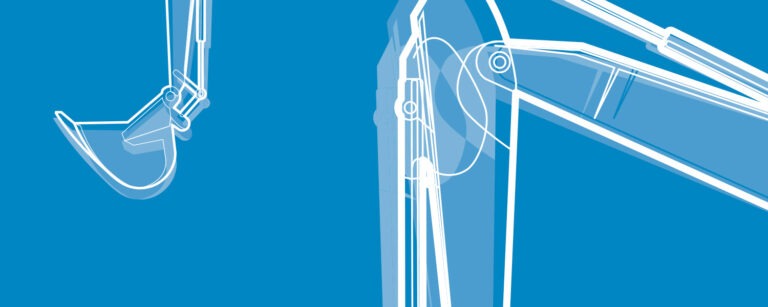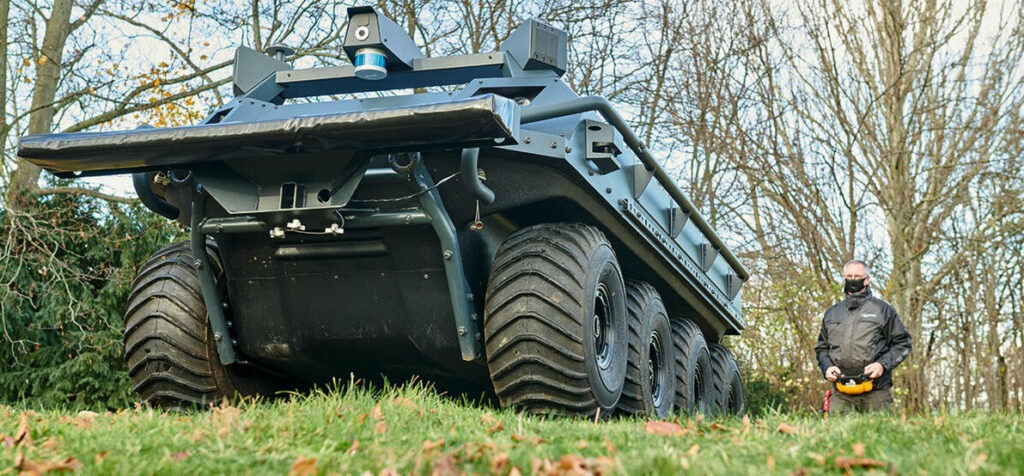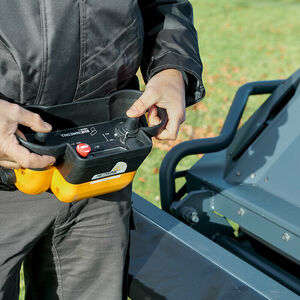
Who’s digging at this time of night...?
19. February 2024

29. November 2022
The unmanned ground vehicle operating in autonomous and semi-autonomous fashion Autonomous vehicles for civilian use are now a hot topic. But whereas numerous manufacturers and service providers are tearing their hair out in the quest for reliable roadworthiness, Rheinmetall’s solution for off-road applications has already proved its worth and high reliability on several occasions.

e’re talking about the Mission Master here, an autonomous unmanned ground vehicle designed for a multitude of different missions. Just under three meters long and weighing in at 1,100 kilos, this four-axle vehicle is powered by two separate electric motors. With its eight all-terrain tires, the Mission Master is thus extremely maneuverable – it can even pivot on the spot. Based on lithium-ion batteries, its electrical charge capacity means that it can operate for eight hours at a stretch, travelling at speeds of up to 30 km/h. Moreover, it can handle steep inclines of up to forty percent and even climb stairs. Nor is this high-mobility mechanical mule afraid of standing bodies of water. Thanks to its encapsulation and special tire treads, the vehicle can cross water obstacles at a pace of up to 5 km/h, while special tire tracks keep the vehicle on the go even through snow.
Award-winning “Mule”
Its 600-kilo payload makes it perfect to execute a wide array of different missions. One of the Mission Master’s major differentiators is its negligible acoustic signature. Like all electric vehicles, it is silent when on the move, and thus relieves the burden on its human companions in more ways than one. Back in 2018, the Mission Master took first prize in the category “Transport/Mule” at the European Land Robot Trial (ELROB) in Lens, Belgium, a bi-annual competition for unmanned vehicles.
The Mission Master owes its autonomous functions to the PATH autonomous kit (A-kit). It provides a wide range of teleoperation options for the Mission Master, including a tablet, smartwatch, soldier system, and single-hand controller. It can also be integrated into digital command and control systems or controlled remotely from inside a vehicle with a computer terminal.

One of PATH’s interesting features is the many navigation options it enables for the Mission Master. For instance, the Mission Master can be ordered to follow a vehicle or person at a specific standoff. Or the operator, who incidentally can intervene at any time, can also select a point on the map as the vehicle’s destination. Alternatively, a predetermined route of march can be transmitted to the Mission Master. Another option is that it can also be ordered to take the shortest route to a specific location, by following forestry roads, for example, exploiting a pre-programmed network of paths and tracks.
And if this wasn’t enough, the Mission Master can memorize fixed routes between two locations that it can then use over and over again on supply runs, for instance. Thus far, these functions are possible only in an off-road setting rather than in traffic. But here, too, special conditions pertain, as Dr. Marc Lemmermann – responsible for marketing the Mission Master in Germany and some other European countries – explains: “Operating off-road is fundamentally different from autonomous driving in town. This means the vehicle needs a different set of sensors in order to contend with ditches and other obstacles not found in ordinary traffic conditions.”
Depending on the task at hand, the Mission Master can, again through the PATH A-kit, rely on different artificial intelligence capabilities. Among other things, object recognition and classification via the vehicle camera systems allows for improved target and obstacle tracking. In addition, expanded situational awareness algorithms can fuse data from onboard sensors to simultaneously create a map and localize the Mission Master so it can still operate if the GPS signal is lost. Another example is the terrain analysis where the Mission Master creates a map and a 3D model of the terrain based on its sensor data, which ensures it navigates challenging terrain safely.
Rheinmetall Canada, the company responsible for developing the system, will be presenting this year a new concept of collaborative work for the Mission Master. Managed by a single operator, the concept consists of multiple Mission Master vehicles efficiently operating as a team in order to accomplish missions of all types. As Dr. Lemmermann notes, “In technological terms, we are way ahead of the competition – but we have to keep up the pace of development. One thing is for sure: electric is unbeatable!”
As far as autonomous driving is concerned, certain aspects of the technology built in Canada will also be used in the development of the automotive field. Many concepts have already been developed together with other Rheinmetall business units. Based on the Group’s comprehensive know-how and expertise, we can expect to see a rise of new products and services in this domain.

The Mission Master can navigate off-road with “level 4” autonomy mode: The vehicle can carry out the mission it is assigned in full autonomy without human assistance in most operations. Nevertheless Rheinmetall is committed to keeping a human in the loop in all kinetic operations.
Depending on the specific mission, various equipment packages are available. The scope of applications range from a purely transport role to a medical evacuation system for recovering wounded personnel. The Mission Master can also serve as a mobile surveillance asset or communication relay station, or in a fire support role for troops operating in particularly hazardous situations.
The Mission Master was originally conceived as a technology demonstrator that would enable a live presentation of the PATH A-kit, which enables state-of-the-art automated driving. The technology is now being integrated into other vehicles for instance within Rheinmetall’s range of military and logistics vehicles. The fact that it has been instantly accepted as a support vehicle augurs well for the future: Several armies are already testing the vehicle operationally. Perhaps in the medium term it is also suitable for civilian sectors such as agriculture, construction, and mines. The Mission Master is poised to make many things possible. The Mission Master makes many things „possible“.
(Article originally published on 19 March 2021)
Click here to receive push notifications. By giving your consent, you will receive constantly information about new articles on the Dimensions website. This notification service can be canceled at any time in the browser settings or settings of your mobile device. Your consent also expressly extends to the transfer of data to third countries. Further information can be found in our data protection information under section 5.